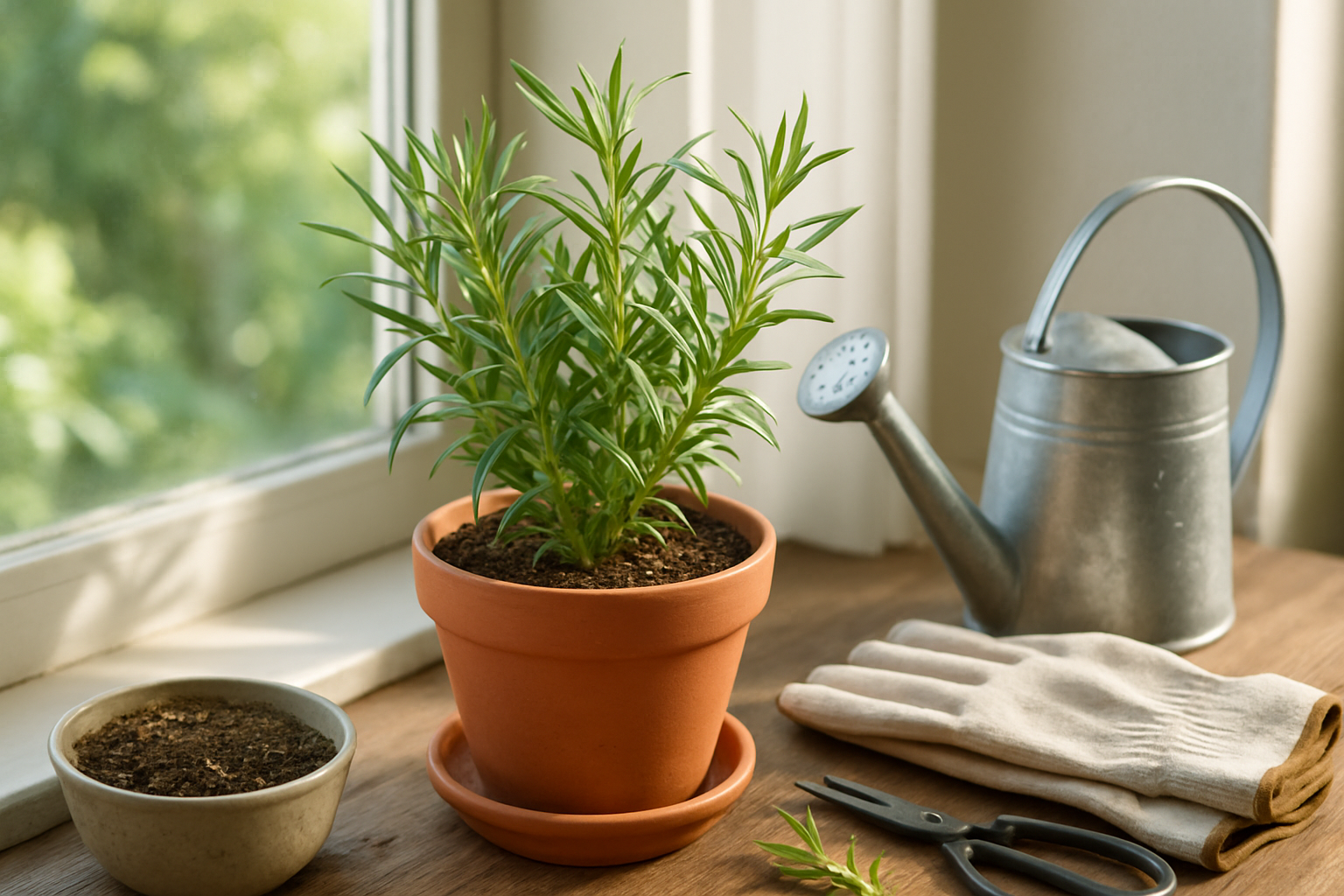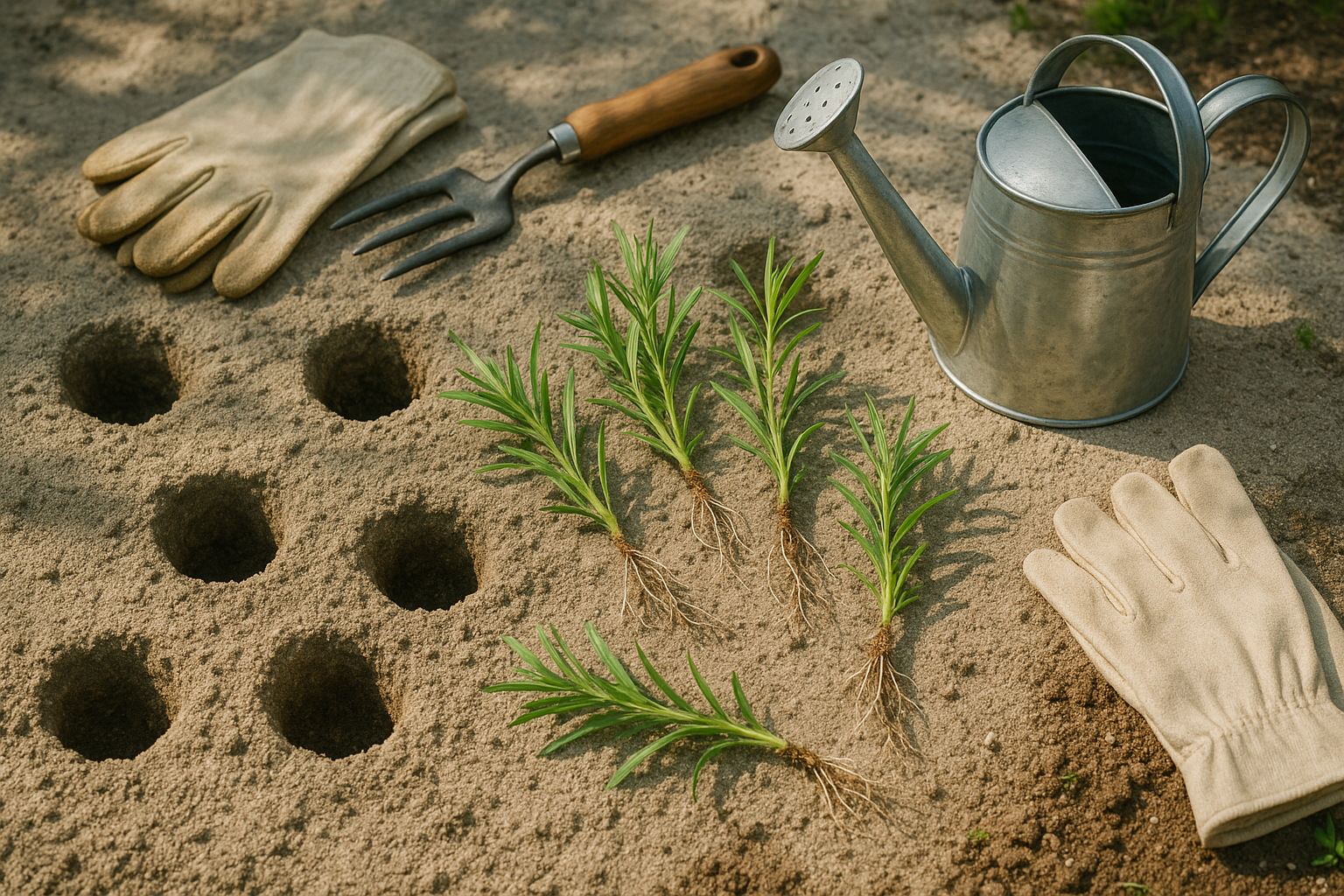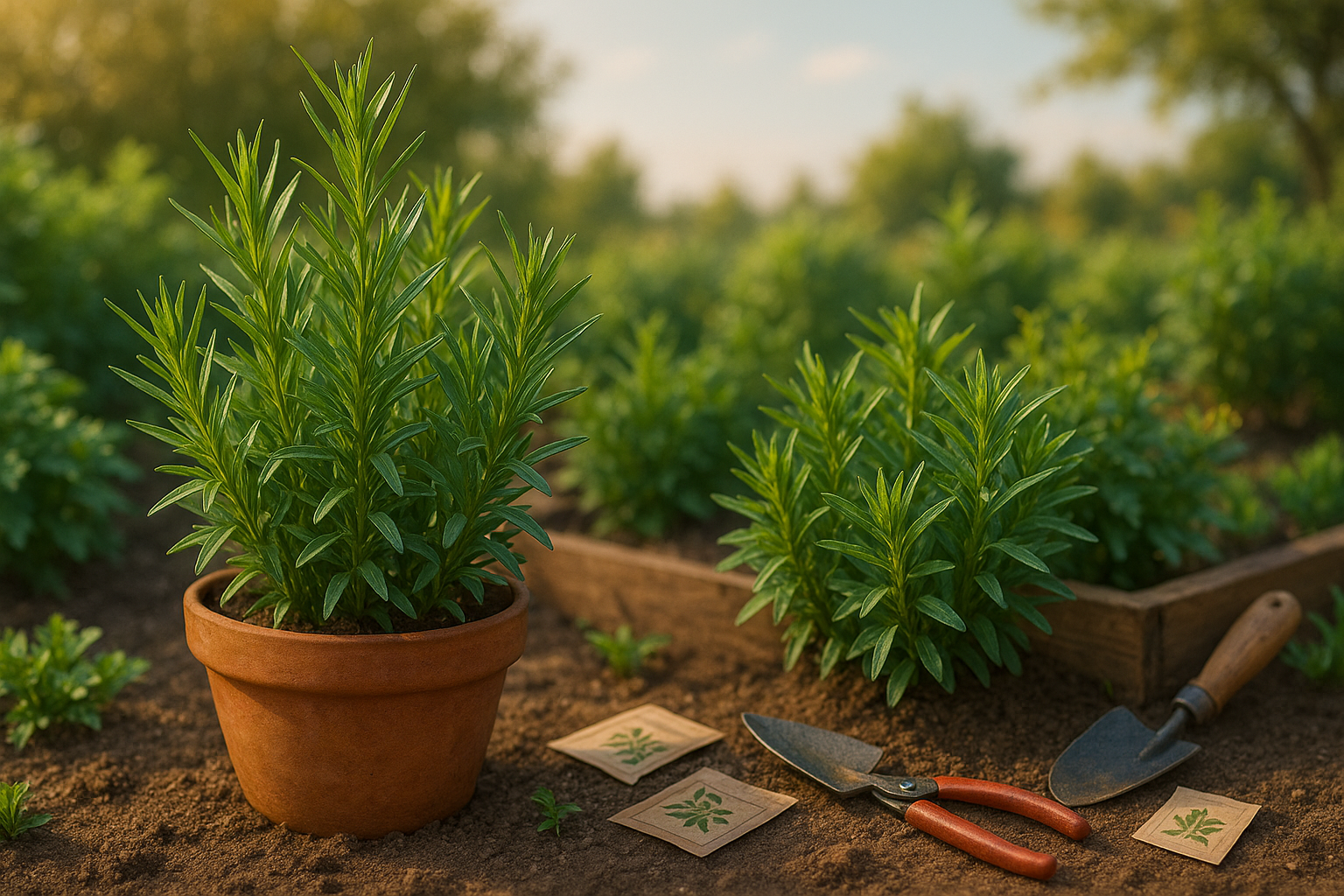How to Grow Tarragon at Home (Beginner’s Guide)

Start growing tarragon at home by choosing the right variety—French tarragon is best for cooking, while Russian tarragon is easier to grow from seed. Since French tarragon rarely produces viable seeds, buy healthy young plants or cuttings from a nursery. Plant them in well-draining soil in a sunny spot, such as your windowsill or garden.
Water your tarragon when the top inch of soil feels dry, but avoid overwatering, as this can cause the roots to rot. Trim back the stems regularly to encourage bushier growth and prevent flowering, which makes the leaves less flavorful. If you live in a colder climate, bring your plant indoors before the first frost to enjoy fresh herbs year-round.
Introduction to Tarragon
If you’ve ever wondered how to grow tarragon and add a fresh, sophisticated flavor to your cooking, you’re in for a treat. Tarragon is a leafy green herb known for its distinctive anise-like taste, often described as a blend of sweet licorice and soft pepper. Highly valued in French cuisine (think béarnaise sauce or chicken tarragon), this herb has found its way into kitchens worldwide.
Tarragon not only brightens salad dressings and marinades but also works magic in simple dishes like roast vegetables or scrambled eggs. There are two main varieties to know: French tarragon, prized for its robust flavor and tender leaves, and Russian tarragon, which is more vigorous but noticeably milder—sometimes even bland in comparison.
French tarragon is the culinary favorite, though it requires a bit more care since it rarely sets seed and is usually propagated from cuttings. Don’t let that intimidate you! Tarragon is forgiving and well-suited to beginner gardeners, thriving in pots or garden beds with minimal fuss. All you need is a sunny windowsill or a patch of well-drained soil, and soon you’ll have a steady harvest for recipes year-round.
Ready to taste the difference homegrown tarragon can make? Let’s get started!
Choosing the Right Tarragon Variety
When selecting tarragon for your kitchen garden, it’s important to know that not all varieties offer the same flavor or grow in the same way. French tarragon is the gold standard for culinary use, boasting a subtle, sweet anise flavor that pairs perfectly with dishes like chicken, fish, and sauces.
Unlike Russian tarragon—which is easier to grow from seed but often disappoints with its rough texture and muted, sometimes bitter taste—French tarragon cannot be grown from seeds. It must be propagated from healthy cuttings or divisions.
Mexican tarragon, sometimes called Mexican mint marigold, is actually a completely different species. However, it’s prized by gardeners in hot climates for its similar anise-like notes and its toughness in poor soil and heat.
For the best cooking results, invest in certified French tarragon from reputable nurseries or specialized online suppliers, especially those who ship live plants or fresh cuttings in the spring. Check your local farmer’s market or herb festivals too—vendors often bring rooted cuttings or divisions of true French tarragon for home cooks.
Always look for healthy, green foliage and avoid plants with yellowing leaves or signs of disease. Remember, French tarragon thrives best in well-draining soil and plenty of sunshine, so give your new plant a prime spot in your herb patch.
Planting Tarragon

Tarragon thrives best in well-drained, sandy or loamy soil with a neutral to slightly alkaline pH—think crumbly, light soil that doesn’t stay soggy after a good rain. Make sure your garden bed or pot gets at least six hours of full sunlight daily, as tarragon’s essential oils, which give it that signature flavor, develop best in bright light.
Early spring is the perfect time to plant, just after the last frost, so the tender shoots can settle in comfortably as temperatures warm up.
Varieties and Propagation
French tarragon must be propagated from cuttings or root divisions since its seeds are sterile. Simply tuck the cuttings into the soil so only the upper leaves remain visible, and keep the soil lightly moist until roots form. Russian tarragon, which is more cold-hardy but milder in flavor, can be grown directly from seed sown after the frost.
Spacing and Placement
Aim to keep each plant at least 18 to 24 inches apart to allow robust airflow and avoid crowded, leggy growth. Tarragon’s versatility makes it perfect for windowsills where it can catch the afternoon sun, patio pots that benefit from sheltered warmth, or tucked into the edge of an herb garden where its straight stems won’t shade out smaller herbs.
Potting Tips
- If you’re using pots, choose containers with drainage holes to prevent waterlogged roots.
- Remember to rotate pots regularly so all sides get sunlight—this keeps your tarragon lush and evenly shaped.
Caring for Your Tarragon Plant
Tarragon thrives when cared for with a mindful routine, starting with proper watering. Since tarragon dislikes wet feet, water only when the top inch of soil feels dry—sticking your finger in the soil is a foolproof way to check. Avoid letting the plant sit in soggy soil or waterlogged saucers, as this can quickly lead to root rot.
Place your tarragon in a sunny spot receiving at least six hours of direct sunlight daily. Indoors, a south-facing window works best, while outdoor plants do well in full sun with some afternoon shade in hotter climates. Tarragon prefers moderate temperatures, ideally between 60-75°F (15-24°C), so bring potted plants inside if frost is expected.
To encourage bushy growth and prevent premature flowering, pinch back the tips of stems regularly—about every other week during the growing season. If you spot any flower buds, snip them off immediately so your plant invests more energy in leaves.
Common Issues and Solutions
- Pests: Watch out for aphids, spider mites, and powdery mildew. An easy organic fix is spraying leaves with diluted neem oil or a homemade soap solution (one teaspoon of mild dish soap per quart of water).
- Root Rot: Prevention is key. Maintain well-draining soil and consider using clay pots, which allow moisture to escape. If roots look brown and mushy, trim away damaged sections and repot in fresh soil.
By following these simple care routines and keeping a close eye out for pests or disease, you’ll enjoy a healthy, lush tarragon plant ready for your favorite recipes.
Harvesting and Storing Tarragon
For the best flavor, harvest tarragon just before it flowers—usually in late spring or early summer—when the leaves are most aromatic. Use sharp scissors or pruning shears to snip stems in the morning, after the dew has dried but before the sun gets too intense.
If you want to use tarragon fresh, you have two easy options:
- Keep the cut stems in a glass of water on your kitchen counter, changing the water daily.
- Wrap the stems in a damp paper towel and store them in a plastic bag in the refrigerator for up to two weeks.
To preserve tarragon for longer, drying is a classic method: tie small bundles of stems and hang them upside down in a cool, well-ventilated spot away from direct sunlight until the leaves become crumbly. Store the dried leaves in an airtight container and use within a year.
Freezing tarragon is just as effective—chop the leaves and pack them into ice cube trays, cover with water or olive oil, and freeze. Once solid, transfer the cubes to a freezer bag for easy portioning in recipes.
Whichever method you choose, always wash and thoroughly dry the tarragon before storing to prevent mold and preserve its vibrant, anise-like flavor.
Cooking and Enjoying Your Homegrown Tarragon
Cooking with fresh tarragon is a fantastic way to add unique flavor and a boost of nutrients to your meals. This leafy herb pairs especially well with chicken, fish, and eggs.
Try making a quick tarragon chicken salad: just mix cooked, chopped chicken breast with mayonnaise, a squeeze of lemon juice, chopped fresh tarragon, and a sprinkle of salt and pepper for a refreshing lunch. Or, whip up a classic French tarragon omelet—beat eggs, whisk in a tablespoon of chopped tarragon, and cook gently in butter for a fragrant, light breakfast.
Tarragon also shines in homemade salad dressings; blend it with olive oil, vinegar, Dijon mustard, and a pinch of garlic for a zesty green drizzle.
Besides its vibrant taste, tarragon provides small amounts of vitamin C, vitamin A, and essential minerals to your dishes. It’s also known for its gentle digestive benefits.
If you’re new to tarragon, start with a small amount—its licorice-like flavor can be strong at first, but it mellows beautifully once cooked or mixed into sauces. Don’t be afraid to experiment; snip a few leaves onto roasted potatoes or toss them with veggies.
Growing this aromatic herb at home means you’ll always have a fresh burst of flavor ready to elevate everyday cooking.
Common FAQs and Troubleshooting Tips
New tarragon growers often wonder why their plants taste bland, develop yellow leaves, or seem stunted. If your tarragon’s flavor isn’t strong, remember that French tarragon develops its signature licorice-like aroma best in warm, sunny spots. Always harvest in the morning for peak flavor, and avoid overwatering, which can dilute its oils.
Yellowing leaves are usually a sign of poor drainage, crowded roots, or overwatering. Let the top inch of soil dry out before watering again, and make sure your pot or garden bed drains well.
If pests like aphids or spider mites appear, spray the leaves (top and bottom) with a gentle blast from a garden hose, or use a mix of mild soap and water to gently wash them away.
Growth issues often improve with a quick check: ensure your tarragon gets at least 6 hours of sun, and trim back any leggy or weak stems to encourage fuller growth.
Lastly, don’t get discouraged if your first season isn’t perfect—herbs like tarragon can be finicky. Try adjusting sun, water, or soil as needed, and keep notes so you learn what works best in your garden. With some patience and a willingness to experiment, your tarragon will thrive!
